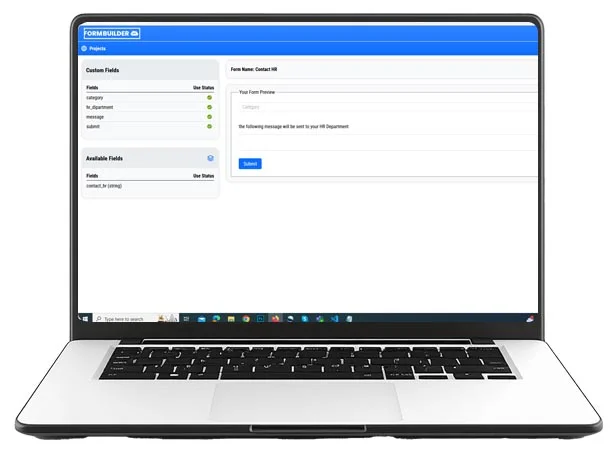
Creating forms is an essential yet time-consuming part of many projects. Whether you’re working on a SaaS application, managing customer data, or collecting feedback, the process of designing, validating, and deploying forms can be overwhelming. With API Form Builder, however, you can accelerate the process significantly using features like auto-generation, schema import, and project mapping.
In this blog, we’ll explore fast form creation tips and form builder hacks to help you speed up form workflows and save time on your next project.
1. Leverage Auto-Generation for Instant Form Creation
One of the standout features of API Form Builder is its ability to auto-generate forms directly from API schemas.
How It Works:
- Import an OpenAPI Swagger URL, JSON file, or OData XML into API Form Builder.
- The tool automatically generates a form based on the structure of your API, including fields, validations, and labels.
Benefits:
- Save Time: Skip manual field creation and let the tool handle the heavy lifting.
- Error-Free: Auto-generated forms align perfectly with your API schema, reducing errors in data mapping.
2. Organize Your Projects for Maximum Efficiency
Use Project Mapping
Efficient project organization is key to managing multiple forms and teams. API Form Builder allows you to group related forms under a single project and map users to specific roles:
- Managers: Oversee projects and approve forms.
- Developers: Focus on form creation and customization.
Set Naming Conventions
Adopt clear and consistent naming conventions for projects and forms. For example:
- “Customer Signup Forms – USA”
- “Feedback Forms – Q1 2025”
Tag Projects
Add tags to categorize projects by region, department, or purpose, making them easier to locate and manage.
3. Customize with Drag-and-Drop Simplicity
API Form Builder’s drag-and-drop interface makes form customization quick and intuitive.
Tips for Customization:
- Add Custom Fields: Insert additional fields not included in the API schema for flexibility.
- Use Predefined Templates: Start with templates for common forms to save time.
- Enable Validations: Apply built-in validation rules, such as required fields or conditional logic, to ensure data accuracy.
Why It’s Fast:
The visual interface eliminates the need for coding, allowing even non-technical users to modify forms effortlessly.
4. Take Advantage of Reusable Components
Field Templates
Save frequently used fields (e.g., Name, Email, Phone Number) as templates and reuse them across multiple forms.
Validation Rules
Set up validation rules once and apply them to similar fields in future projects, ensuring consistency and speed.
Export and Import Options
Export forms as schemas or ZIP files for reuse in different environments or projects, saving time on repetitive tasks.
5. Preview and Test in Real-Time
Before deploying your form, preview it in real-time to catch any errors or inconsistencies. API Form Builder provides a live preview feature that allows you to:
- Test field behavior and validations.
- Check layout compatibility across devices.
- Identify and fix potential issues before publishing.
6. Use Role-Based Access for Team Collaboration
Role-based access ensures the right people handle the right tasks, reducing delays caused by overlapping responsibilities.
Example Workflow:
- Managers: Approve the project scope and assign developers.
- Developers: Create and edit forms within assigned projects.
- Admins: Monitor overall progress and handle deployment.
This streamlined collaboration prevents bottlenecks and ensures faster form creation.
7. Monitor Progress with the Dashboard
API Form Builder’s centralized dashboard provides an overview of all projects, forms, and team activities. Use it to:
- Track project completion statuses.
- Identify bottlenecks and reassign tasks as needed.
- Generate reports for stakeholders.
Why It Helps:
A clear view of progress keeps teams aligned and ensures that no project falls behind schedule.
[Image Placeholder: Project tracking dashboard with progress indicators]
8. Export Forms for Quick Deployment
Once a form is finalized, API Form Builder allows you to export it in multiple formats:
- Schema Export: Ideal for integrating forms directly with APIs.
- ZIP File Export: Includes all assets for deployment to other environments.
This feature eliminates the need for manual packaging, speeding up the deployment process.
9. Real-World Impact of Faster Form Creation
Case Study: SaaS Platform Onboarding Forms
- Scenario: A SaaS platform needed onboarding forms for new users across five regions.
- Solution: API Form Builder auto-generated forms using regional API schemas and applied reusable components for consistency.
- Outcome: Form creation time was reduced by 60%, and deployment was completed two weeks ahead of schedule.
Case Study: E-Commerce Checkout Forms
- Scenario: An online retailer required customized checkout forms for different countries.
- Solution: The team used project mapping and validation rules to create compliant forms quickly.
- Outcome: Reduced form errors by 40% and improved customer satisfaction.


